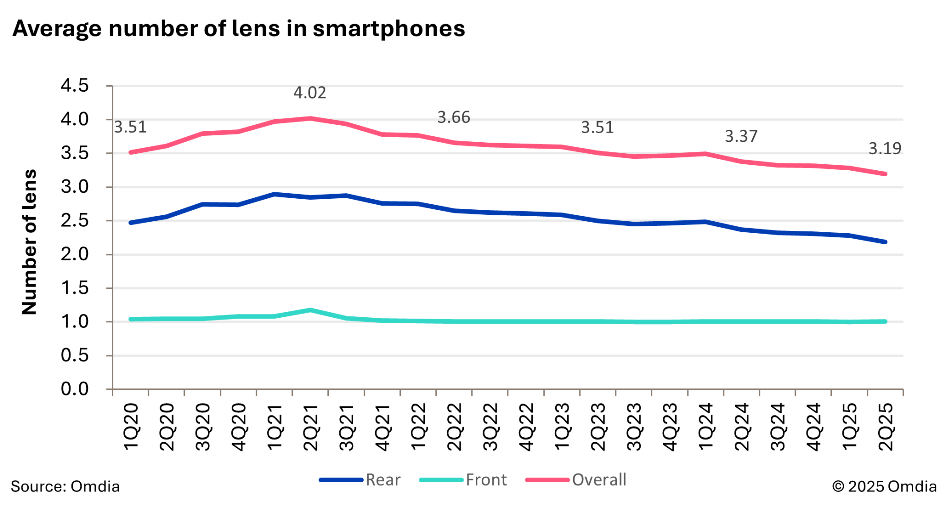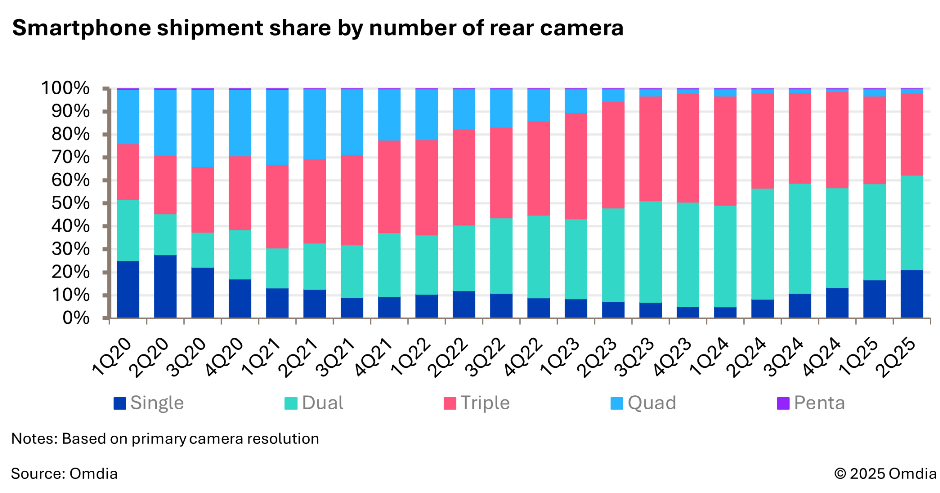The way we use smartphone cameras is evolving rapidly. According to Omdia’s Smartphone Model Market Tracker 2Q25 report, the number of camera lenses in smartphones is declining, even as image quality continues to improve. For consumers, this shift means smarter, more capable cameras without the bulk of multiple lenses.

Fewer Lenses, Smarter Design
In the second quarter of 2025, smartphones shipped with an average of 3.19 camera lenses, down from 3.37 in the same period last year. While this figure includes both front and rear cameras, the decline is primarily due to fewer rear cameras, as most smartphones still rely on a single front-facing lens for selfies.
The downward trend in rear cameras has been consistent. Smartphones in 2Q25 featured an average of 2.18 rear cameras, compared to 2.37 in 2Q24. After peaking at 2.89 lenses in 1Q21, the industry has seen a steady decline over 13 consecutive quarters.
Jusy Hong of Omdia highlighted that fewer smartphone camera lenses reduce costs and create room for bigger batteries, and predicted that AI-driven photography will further drive the decline in lens numbers.

For consumers, this change means sleeker phones with less camera bump, simpler designs, and potentially lower prices on new models.
Popular Rear Camera Configurations
Dual rear cameras: 41 percent of shipments
Triple cameras: 36 percent of shipments
Single cameras: 21 percent of shipments
The rise of single-camera smartphones is fueled by models like Apple’s iPhone 16e and Samsung Galaxy S25 Edge, which focus on optimized software and AI processing rather than multiple lenses.
Higher Resolution Cameras Are the New Standard
While the number of cameras is dropping, their quality is improving. Consumers now prioritize high-resolution sensors over sheer camera count.
50MP-class cameras now account for 58 percent of shipments
Cameras with over 100MP sensors make up 9 percent
Cameras below 15MP have declined sharply to 12 percent, compared to 54 percent five years ago
This means consumers can expect better image quality in low light, sharper detail, and advanced AI photography features, even with fewer lenses.
Benefits for Consumers
Larger batteries: Fewer camera lenses free up internal space for bigger batteries, leading to longer usage time.
Lower costs: Simplified camera modules can help manufacturers reduce costs, potentially lowering smartphone prices.
AI-driven photography: Smart algorithms now compensate for fewer lenses, offering professional-quality photos without manual adjustments.
Market Impact and Component Demand
The declining camera count is also affecting the smartphone component industry. Omdia forecasts a 4.3 percent year-on-year drop in global demand for smartphone CMOS Image Sensors (CIS) in 2025, with total shipments expected to reach 4.19 billion units.
For consumers, this shift signals a more efficient and technology-focused approach to smartphone design: fewer lenses, better images, and longer-lasting devices.
What Consumers Should Look For
When buying a new smartphone in 2025, consumers should focus on:
Camera resolution over the number of lenses.
AI and software features for improved photography.
Battery size and efficiency, as space is freed up from reduced camera modules.
Balanced design, ensuring a premium feel without bulky camera bumps.
Conclusion
Smartphone photography in 2025 is no longer about the number of lenses — it’s about quality, AI optimization, and consumer convenience. Whether you’re a casual snapper or a photography enthusiast, the latest smartphones offer smarter cameras that deliver stunning photos, longer battery life, and a sleek design — all without multiple camera lenses.
